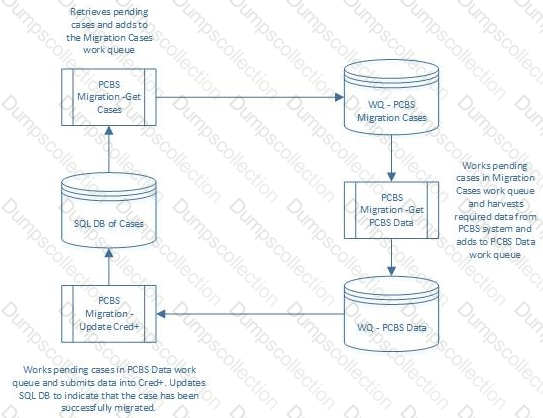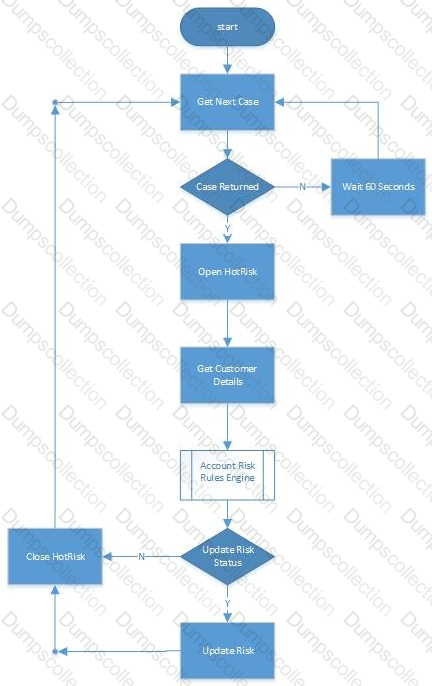Blue Prism Designing Blue Prism Process Solutions ASD01 Exam Dumps: Updated Questions & Answers (November 2025)
MedBank have recently introduced a new Credit Card platform Cred+. There is a requirement to migrate account and card details from the existing banking platform PCBS on to Cred+.
Account IDs of the cases requiring data transfer will be held on a SQL database. The requirement is that, for each account ID specified on the SQLdatabase, the following data must be read from the PCBS application and input into the Cred+ application:
Account ID
Product Type
Name
Address
Date of Birth
Card PAN (Primary Account Number or credit card number)
Card Issue Date
Card Expiry Date
Once the data has been successfully input into Cred+ the correct record on the SQL database will be updated to indicate data transfer is complete. All work queues will be encrypted, however due to the sensitivity of the data, MedBank insist that a single robot account does not have access to both PCBS and CRED+ systems.
The following high level design has been proposed:

Which of the following statements about the solution design are correct? (Choose two.)
It’s technically possible for one business object to call another. Outside ofusing utility objects are any of the following valid reasons why you would want to do this?
Imagine a DR scenario where themain Production database goes down one afternoon. All processes use work queues and all new work is loaded first thing each morning. The database is backed up regularly but not in real time, so the restored back up will be slightly out of date, say by 1 hour.
If the backup was restored, and processes were restarted what would be the effect? (Choose two.)
Which of the following statements about using Work Queue designs to split a business process into a multi part robotic solution is correct?
1. Using multiple Work Queues and Processes for the different stages of the business process is a valid design option to split a business process into a multi partrobotic solution.
2. Using a single Work Queue and deferring cases for future processing is a valid design option to split a business process into a multi part robotic solution.
3. Using an item’s status to control when to work it is a valid design optionto split a business process into a multi part robotic solution.
4. You cannot split a business process into a multi part robotic solution.
A process definition document has been produced for a process that interfaces with two applications: FirstApp and Customer Information (CI). The process requirement is to perform data extractionfrom FirstApp before performing a number of steps in the CI application.
It is estimated that to perform the daily case volume within SLA’s will require 10 robots. Average case time is approximately 10 minutes, with the FirstApp steps requiring only 1 minute to perform.
The client has a limited number of licenses for the FirstApp application and is reluctant to use 10 of these licenses to automate the process.
Which of the below is a valid design option for the project?
Which of the following statement combinations about Blue Prism memory management is correct?
When designing business objects which of the following statements is true? (Choose three.)
ProSafe credit reference agency retrieves data from bank and other credit providers where customers have missed payments or gone into default. The data isvery sensitive and fed directly into a Blue Prism work queue via a web service. Blue Prism process must process the data within 4 hours. The Blue Prism solution runs continuously and each case takes approximately 30 seconds to process. It is expected thatan average of 10,000 cases per day will be required and up to 10 Blue Prism robots are available. The Blue Prism solution is sown below:

For each case of the process will access the customer account in the HotRisk system and, where an account exists, harvest the data which will be fed along with the Work Queue data into a rules engine. The rules engine is a Blue Prism process that does not interact with any target system. It merely consumes data and, via a complicated series of decision and choice stages, determines the new customer risk factor.
There is to be no scheduler used. Instead the Process Controllers who work in shifts to provide 24 hour support will stop and start process instances in line with Work Queue volumes.
As a Blue Prism process solution designer, who is reviewing the solution, which of the following would concern you? (Choose three.)

